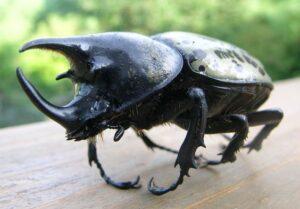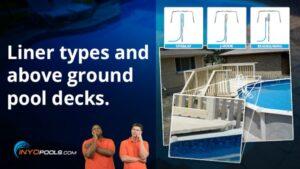After building above ground pools for many years, I don’t get many callbacks on my bottoms. Some above grounds are made with bottoms of foam sheeting, happy bottoms (which are thin sheets of hard plastic), vermiculite, pearlite, or concrete.
The vast majority of them use only the earth of the yard and maybe some sand for the bottom and that’s perfectly OK. An experienced installer can make a nice smooth bottom using just the earth that is there. We usually use only the earth for the pool bottom due to the extra cost of the materials mentioned above. An above ground swimming pool is, after all, a much less expensive alternative to in-grounds. So, for most, keeping the cost down is important.
There are a few drawbacks to having only an earth bottom and one of the drawbacks is horned nosed beetles. I started this blog post saying that I don’t get many callbacks on my bottoms, but I did get three this season because of something sharp poking up from under the liner. Out of the three calls, one was because of a horned nosed beetle. Let me tell you about them.
What Is a Horned Nosed Beetle?

Seems like a stupid question, but hey, I have to start somewhere. A horned nosed beetle is a medium-sized dark brown bug that lives just below the surface. He (or she) has a body armored with a super hard dome shaped shell and a separate shelled head. Most of these brown bugs don’t have horns, but a few do. They have three little, but very sharp horns, protruding from (what it appears to me to be) the top of their heads.
Useless opinion: I don’t know why they are called horned nosed beetles as the horns are clearly on top of their heads. Maybe the name horned “headed” beetles doesn’t roll off the tongue well or just “horned beetles” wasn’t specific enough. Doesn’t matter much I guess, so never mind. These not so cute little guys burrow under the soil and that’s a problem for above ground pools. It’s a problem for them too if they get caught under one.
I Have Something Sharp Under My Pool Liner. How Do I Tell If It’s a Horned Nosed Beetle?
It can be hard to tell. The last call I got for one under a liner was difficult even for me to determine. Lucky for me, the pool owner clipped off one of the horns sticking through the bottom of his pool before I got there thinking it was a piece of wire. I thought it was a piece of wire too when I dove down to look at it. When he brought out the saved horn piece, I was relieved knowing it wasn’t something I left in the ground. It was in fact a horned nosed beetle. Not my fault. Whew!
I couldn’t determine then if it were a beetle, but there are two ways you can tell sometimes. One is if you feel three little sharp points that make up a kind of a triangle, it’s probably a beetle. Also, if there is a small rut or trail leading to the sharp spot, it’s probably a beetle. Sometimes the beetle will have only one or two horns and won’t leave any kind of a trail at all so that doesn’t help. Also, beetles don’t usually make it very far before they try to surface so they will poke through the liner only about a foot or so from the pool wall.
OK, So It Is a Horned Nosed Beetle. What Do I Do Now?
So you’ve got this hard shelled bug trapped under your pool liner with his horns making one or two or three small holes in it. What now? Well, first off, if you do yoga, hug trees, and trap spiders inside your house so you can put them outside, cover your ears. The beetle is dead! By the time you feel his horns, he is long gone. Some of you won’t believe me and will try to save him. That’s cool and good for you. Here are two ways to fix your pool:
For trying to save him (not recommended):
- Run to the store and get an underwater vinyl patch kit.
- Using a sharp utility blade, go down to where the beetle is and make a slice in the liner directly over him. Make the slice only big enough to get him out. Don’t worry about cutting the beetle. He has a badass shell.
- With the knife or a fork or something, pry him out from under the liner and bring him to the surface.
- If he eventually moves around, congratulations. You saved a beetle. Now you can get an I-saved-a-horned-nosed-beetle sticker for your Prius.
- Now patch the big hole you just cut following the kit’s directions and you’re done.
The meat eater’s way (recommended):
- Get an underwater vinyl patch kit.
- Go down with a hammer to where the beetle has made a hole in your liner.
- Gently tap the beetle’s protruding body and horns flat so that it is level with the rest of the smooth pool bottom. If gentle taps won’t get him down, hammer him down hard!
- Now patch the hole made by the horn and you’re done.
Preventing Horned Nosed Beetles From Getting Under Your Pool Liner
It is really rare for horned nosed beetles to make holes in above ground pool bottoms. Most areas don’t have them and even if your yard has them, it doesn’t mean they will go under your pool. I’d estimate that maybe one in every 500 to a 1000 pools will have this issue so it’s not worth doing anything.
If you know you have these horny beetles in your yard and you are getting a pool, you could get one of the bottom materials I mentioned at the beginning, but I wouldn’t even do that. I would instead wait and see if it’s a problem and just fix it when it happens. It’s no big deal really.












Leave a Reply